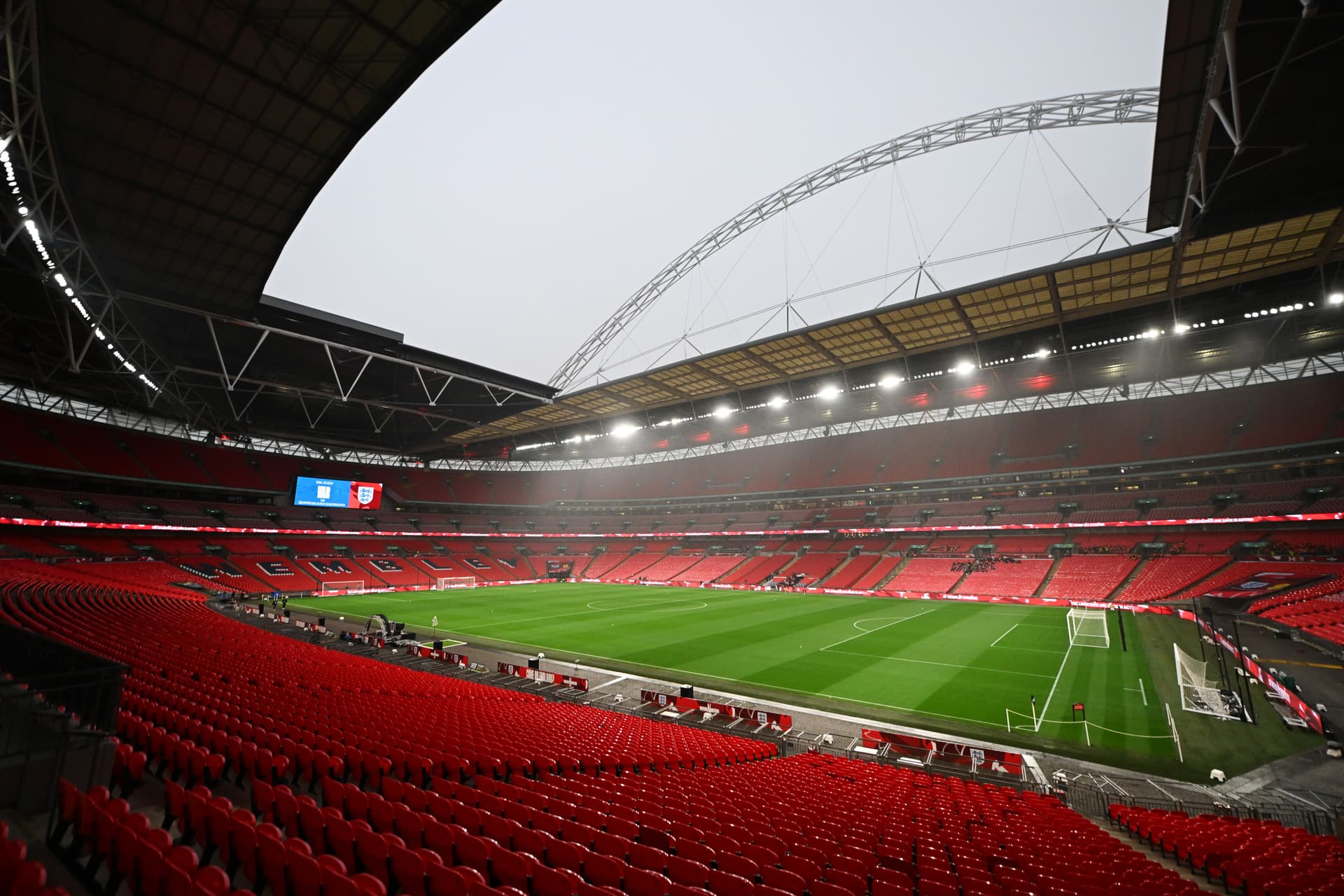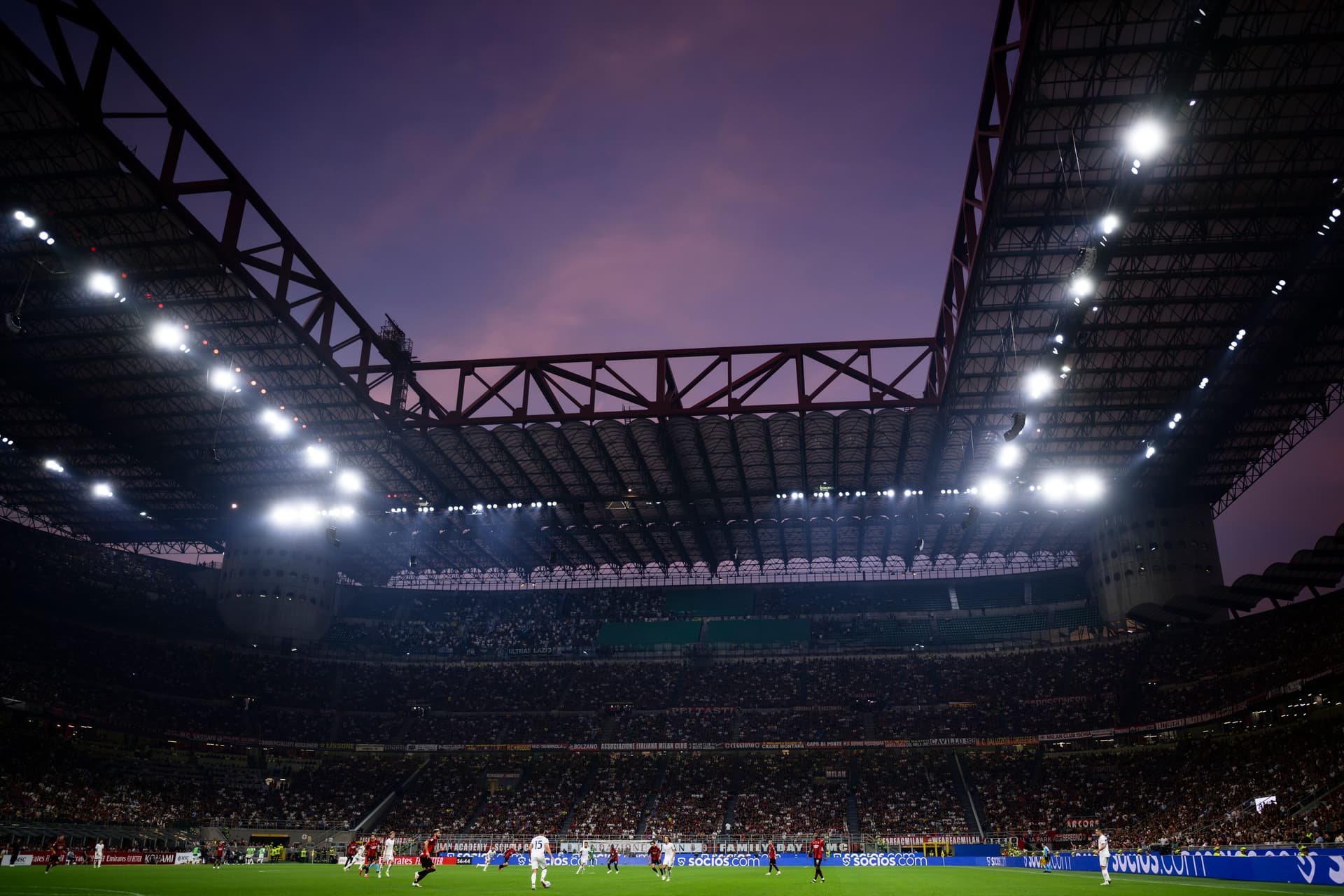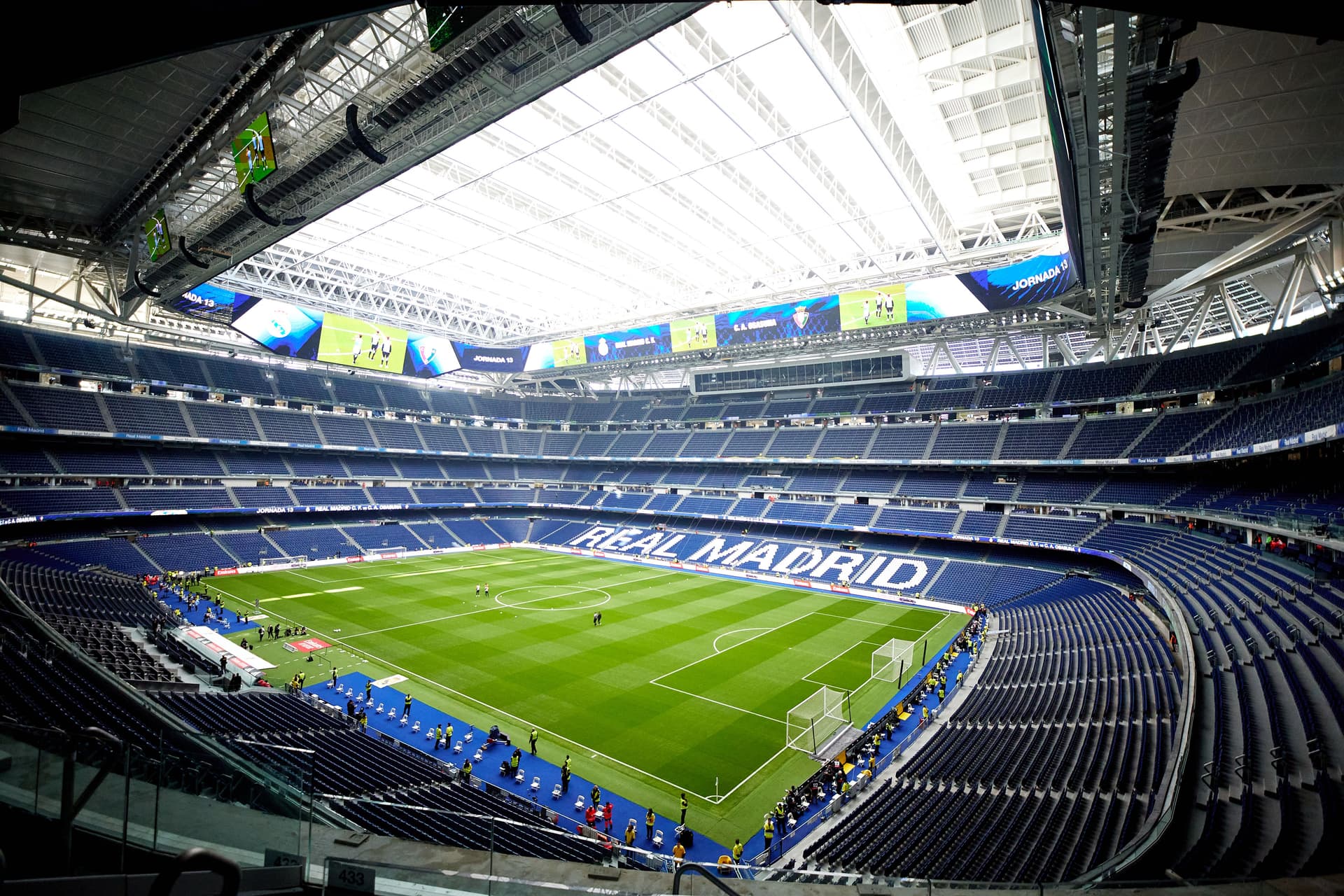Football
Top 13 Largest Football Stadiums in the World
Football stadiums play a big role in setting up the occasion and letting fans enjoy the live experience.

General view of Wembley Stadium//Getty Images
Football is the most played and followed sport around the globe. Football is a game you can play everywhere and anywhere and all the time. But football stadiums play a big role in setting up the occasion and letting fans enjoy the live experience.
Some clubs have been hosting their home matches in their legendary stadiums and have decided to renovate their legendary homes to keep going forward. Other clubs decide to build completely new stadiums to take their sporting project forward.
The example of Arsenal moving to the Emirates Stadium in 2006 from their previous home, Highbury, while the recent example of Tottenham Hotspur also comes to mind. Spurs moved to the Tottenham Hotspur stadium in 2019 from the Old White Hart Lane.
On the other hand, clubs like FC Barcelona and Real Madrid have spent a lot of money to revolutionize their old homes into modern sports enterprises.
One of the most iconic stadiums in the world, Old Trafford seems to be next in line for a makeover. With new Manchester United owner Sir Jim Ratcliffe and INEOS looking to build a new stadium right next door to Old Trafford. With the idea of “Wembley of the North” in the plans. The future of Old Trafford still remains undecided as the club could demolish the stadium or use the stadium as a secondary stadium for women’s team and youth team matches.
With all this information in mind, let’s move forward and take a look at the top 13 largest football stadiums in the world.
The 13 biggest football stadiums in the world
| Rank | Name | Home team | Capacity |
| 1 | Rungrado 1st of May Stadium | North Korea national football team | 114,000 |
| 2 | Michigan Stadium | University of Michigan | 107,601 |
| 3 | Camp Nou | FC Barcelona | 99,354 |
| 4 | FNB Stadium | Kaizer Chiefs | 94,807 |
| 5 | Wembley Stadium | England national football team | 90,000 |
| 6 | Estadio Azteca | Club America and Cruz Azul | 87,523 |
| 7 | Santiago Bernabéu | Real Madrid | 85,000 |
| 8 | Estadio Más Monumental | River Plate | 84,567 |
| 9 | Signal Iduna Park | Borussia Dortmund | 81,365 |
| 10 | Estadio Monumental | Club Universitario de Deportes | 80,093 |
| 11 | San Siro | AC Milan and Inter Milan | 80,018 |
| 12 | Stade des Martyrs | AS Vita Club | 80,000 |
| 13 | Maracanã Stadium | Flamengo, Vasco da Gama and Fluminense | 78,838 |
13. Maracanã Stadium (Flamengo, Vasco da Gama and Fluminense - 78,838)
Home to two of the biggest Brazilian clubs, Flamengo and Fluminense, the Maracana Stadium is one of the biggest and most historic venues in world football. The stadium currently holds a capacity of 78,838.
The stadium was originally built for the 1950 World Cup in Rio de Janeiro. The stadium hosted seven matches during the competition and even saw a record attendance of 199,854 when Uruguay beat the hosts in the final.
Since then, the Maracana stadium has been rebuilt on numerous occasions. The stadium still holds key importance in world football and recently held the final of the 2014 FIFA World Cup and 2019 Copa America.
12. Stade des Martyrs (AS Vita Club - 80,000)
The Stade des Martyrs, with a capacity of 80,000 is the largest stadium in the Democratic Republic of the Congo and one of the biggest stadiums in Africa. The stadium acts as the home for the Congolese football national team, Association Sportive Vita Club, and Daring Club Motema Pembe.
It was constructed in 1993 and was later renamed in 1997. Built at a cost of $38,000,000, it has an official capacity of 80,000 but can be extended to 100,000.
11. San Siro (AC Milan and Inter Milan - 80,018)

General view of Giuseppe Meazza stadium//Getty Images
The San Siro holds a historic importance in European football. It is the largest football stadium in Italy and is the home to rivals AC Milan and Inter Milan.
The San Siro has held many FIFA World Cup games, four European finals and many rock concerts. It currently holds a capacity crowd of 80,018. The great football site was set to be demolished after hosting the opening ceremony of the 2026 Winter Olympics.
Both AC Milan and Inter Milan were in favour of building a new modern stadium, but the San Siro has been saved from demolition due to its cultural heritage.
10. Estadio Monumental (Club Universitario de Deportes - 80,093)
The Estadio Monumental is a football stadium in the district of Ate in Lima, Peru. It serves as the home of Club Universitario de Deportes. It was opened in 2000 to replace the Estadio Teodoro Lolo Fernandez.
After its expansion in the early 2020s, the stadium’s capacity was increased to 80,093. This expansion made it the second-largest stadium in the continent.
The stadium has hosted some matches of the Peru national football team, while also hosting the 2008 Copa Peru. It also hosted the 2019 Copa Libertadores final.
9. Signal Iduna Park (Borussia Dortmund - 81,365)
Signal Iduna Park is the home to Bundesliga giants Borussia Dortmund. The stadium was officially opened in 1974 and holds a maximum capacity of 81,365 for domestic matches.
Signal Iduna Park is also home to the famous “Yellow Wall”, which can hold 25,000 fans. The Yellow Wall is the largest free-standing grandstand in European football. The Signal Iduna Park is one of the most beautiful stadiums in world football due to its atmosphere and fans. The stadium is one of the top stadiums every football fan must visit at least once in their lifetime.
After its official opening in 1974, the stadium has undergone many renovations, with the last one coming in 2006 ahead of the FIFA World Cup.
8. Estadio Más Monumental (River Plate - 84,567)
Estadio Mas Monumental directly translates to More Monumental Stadium. The Estadio Monumental holds an official capacity of 80,093. While the Estadio Mas Monumental holds an official capacity of 84,567, it is the largest stadium in Argentina and South America.
The stadium was opened on 26 May 1938 and is also the home of the Argentina national football team. The stadium hosted the 1978 FIFA World Cup final between Argentina and Netherlands. It has also hosted four Copa America finals, the most recent one in 2011.
7. Santiago Bernabéu (Real Madrid - 85,000)

Inside view of Estadio Santiago Bernabeu//Getty Images
The Santiago Bernabeu is the second-largest stadium in Spain and one of the biggest stadiums in Europe. The home of Real Madrid has been undergoing renovation since 2019. The club have spent north of €1 billion on the stadium, in the hope of making it the best stadium in world football.
The new Bernabeu holds an official capacity of 85,000, with the addition of a retractable pitch and roof. The recent superstar signing of Kylian Mbappe also points to the fact that the club are moving to a new era.
The 2030 FIFA World Cup will be hosted by Spain, Portugal and Morocco. Real Madrid’s new and upgraded Santiago Bernabeu will host the final of the tournament.
6. Estadio Azteca (Club America and Cruz Azul - 87,523)
Estadio Azteca is one of the most iconic venues in world football. It is set to become the only stadium to host three FIFA World Cup editions when Mexico co-host the 2026 edition of the tournament.
The stadium has witnessed some iconic moments in football history. The 4-1 demolition of Italy by Brazil in the 1980 FIFA World Cup final and the famous “hand of god” goal by Diego Maradona when Argentina beat England during the 1986 FIFA World Cup final.
The stadium currently serves as the home ground to Mexican top-flight teams Club America and Cruz Azul. The capacity of Estadio Azteca was reduced to 87,523 after a revamp in 2016.
5. Wembley Stadium (England national football team - 90,000)
Wembley Stadium is one of the most iconic venues in world football. The new Wembley stadium was opened in 2007 at a whopping cost of almost £800 million. It holds an official capacity of 90,000. Wembley Stadium acts as the home to the England national football team and also hosts the FA Cup and EFL Cup finals.
The Wembley Stadium also acted as the home to Tottenham, while their new stadium was being built. The iconic stadium has hosted the UEFA Champions League final and also hosted the 2020 UEFA Euros final.
4. FNB Stadium (Kaizer Chiefs - 94,797)
Located in Johannesburg, South Africa, the FNB Stadium is the biggest stadium in Africa. It hosts football matches as well as Rugby matches. The stadium is best remembered for hosting the World Cup 2010 final match between Netherlands and Spain.
The stadium was opened in 1989 and it has been renovated a couple of times since then. The FNB Stadium is the home ground for the South African national team, and it also hosts the home games of domestic outfit Kaizer Chiefs. The stadium has also hosted AFCON games.
The stadium boasts an official capacity of 94,736.
3. Camp Nou (FC Barcelona - 99,354)
FC Barcelona’s home Camp Nou is the biggest football stadium in the world with an official capacity of 99,354. The stadium is still under major renovation and will have its capacity to 105,000, once work is completed in 2026.
The stadium hosted five games at the 1982 World Cup as well as the 1999 Champions League final between Manchester United and Bayern Munich. The Camp Nou will also host matches of the upcoming 2030 FIFA World Cup.
The stadium currently undergoes the name of Spotify Camp Nou, after the company’s deal with FC Barcelona.
2. Michigan Stadium (University of Michigan - 107,601)
Michigan Stadium, home of Michigan Football, holds an official capacity of 109,901. The stadium was built in 1927, nicknamed "The Big House". It is the largest stadium in America and the third-largest in the world. The stadium currently hosts University of Michigan home games, it is known for its historic significance and passionate fanbase.
1. Rungrado 1st of May Stadium (North Korea national football team - 114,000)
The Rungrado 1st of May Stadium is a multi-purpose stadium in Rungra Island, Pyongyang, North Korea. It opened on 1 May 1989, with its first major event being the 13th World Festival of Youth and Students. It is the second largest stadium in the world by seating capacity, after Narendra Modi Stadium in India. Upon opening its capacity was set at 150,000, the largest in the world. The stadium currently holds a capacity of 114,000 spectators. The stadium currently works as the home of the North Korea national football team.

With over a decade of experience in sports writing, Hardik Malhotra has built a distinguished career in the internet industry. His expertise spans across various domains including Art Direction, Web Content Writing, and Content Management, all underscored by a high degree of initiative. Hardik’s passion for sports is reflected in his professional journey and personal interests.